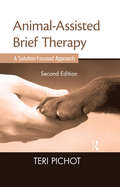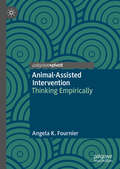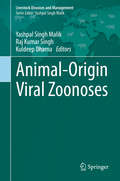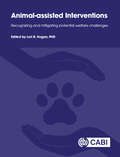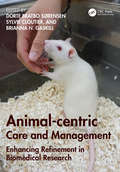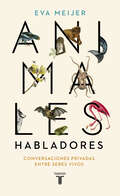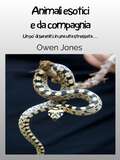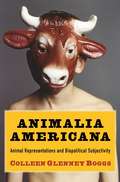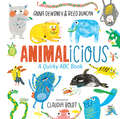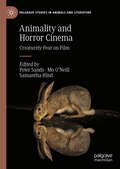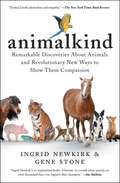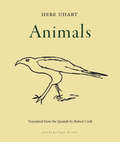- Table View
- List View
Animal-Assisted Brief Therapy: A Solution-Focused Approach
by Teri PichotThis book provides an overview of Animal-Assisted Activities (AAA) and Animal-Assisted Therapy (AAT) and demonstrates how they can be incorporated into solution-focused treatment programs. Pichot, focusing on the use of therapy dogs, starts with a discussion of the basics of AAA/T and solution-focused therapy, as well as what every practitioner should know about dogs before partnering with them. Successfully combining all of this into an effective treatment program is considered next. Pichot draws upon her own experience developing an AAA/T program in the substance abuse counseling program at a county public health agency to illustrate the effective implementation of such a program and the struggles and lessons learned in doing so. Using AAA/T with special populations, cultural considerations, and the impact a therapy dog can have on the handler. New in this edition are client scenarios that demonstrate the therapist’s thought process when making clinical decisions about when and how to use a therapy dog. Sample forms and treatment plans are also provided that professionals can use to modify or structure in their work with clients. The concepts and information provided in this valuable guide will be helpful for any therapist regardless of whether he or she is in private practice or working in an agency setting.
Animal-Assisted Intervention: Thinking Empirically
by Angela K. FournierThis book brings the animal into the scholarly discussion of animal-assisted therapy and other interventions. Challenging the current reliance on outcome studies, the author offers a new way of thinking empirically about animal-assisted interventions—analysis of human-animal interaction as a critical component. Through empirical demonstrations from laboratory and applied settings, the book encourages practitioners and scholars to undergo a deeper examination of the basic interactions that occur between clients or patients and therapy animals. Dr. Fournier provides new ideas on measurement, experimentation, and interpretation of human-animal interaction, aimed at identifying the role of the animal in interventions for human health and well-being.
Animal-Origin Viral Zoonoses (Livestock Diseases and Management)
by Kuldeep Dhama Yashpal Singh Malik Raj Kumar SinghThis book is the second volume in the series Livestock Diseases and Management, and reviews the importance and implications of animal origin viral zoonoses. It also highlights the specific etiology and epidemiology of these viral infections and discusses their various biological and mechanical transmission mechanisms. Further, the book reviews various measures for controlling viral zoonoses and examines novel therapeutic and prophylactic strategies.Discussing recent studies on the pathogenesis and host immune response to these infections, it underscores the importance of using vaccines against these viral diseases to reduce the risk of them being transmitted to humans.Lastly, it describes in detail the challenges posed by these viral infections and our readiness to face them.
Animal-assisted Interventions: Recognizing and Mitigating Potential Welfare Challenges
by Temple Grandin Helen Lewis Amy Johnson Susan D. Greenbaum Ashley Thompson Aubrey H. Fine Veronica Lac Patti Anderson Nicky Barendrecht-Jenken Anna Van Berg Darlene Blackman Eileen Bona Donna Clarke Linda Chassman Craddock Yvonne Eaton-Stull Cynnie Foss Angela Fournier Megan French Nina Ekholm Fry Lisa-Maria Glenk Taylor Chastain Griffin Joy R. Hanson Terri Hlava Ann R. Howie Batya Gugenheim Jaffe Suzanne M. Kapral Jean Kirnan Ursula A. Kohl Elizabeth A. Letson Kirsty MacQueen Arieahn Matamonasa-Bennett Angela M. Moe Julie Ann Nettifee Zenithson Ng Brittany Panus Caiti Peters Laura Poleshuck Missy Reed Elizabeth Ruegg Brenda Rynders Sarah Schlote Shira Smilovici Risë VanFleet Melissa Y. Winkle Katrina WinsorThis is a practical book exploring how to conduct animal assisted intervention (AAI) in ways that protect and prioritize animal and human welfare. This resource is for social scientists (e.g., psychology, social work, human development and family studies, etc.), as well as ethologists and animal behaviour and welfare students and practitioners. The book is a series of short chapters that depict a wide array of AAIs and their potential welfare concerns. The chapters include descriptions of the AAI offered, the welfare challenges, and ways to successfully mitigate these challenges. This book also covers critical topics including therapy animals' aging, retirement, and death as well as ethical issues including animal consent. Species include not only dogs, but horses, rabbits, and other small animals (e.g., guinea pigs, mice, etc.). Types of AAI involve individual interventions as well as crisis dogs (those who help after natural and man-made disasters), and residential animals. The book is designed to be a practical, engaging book with links to video and examples of real-life situations. It is evidence-based, yet user-friendly and directly applicable to students and practitioners. This highly practical and engaging book with examples of real life situations, videos and case studies, explores how to conduct animal assisted interventions in ways that protect and prioritize animal and human welfare. The book: · Explores how to conduct animal assisted intervention (AAI) in ways that protect and prioritize animal and human welfare. · Discusses potential welfare challenges including how to advocate for the animal, animal consent, and the animal's aging, retirement, or death. · Evidence based approach to mitigating welfare concerns for a wide range of therapy animals including dogs, horses, rabbits, rodents, and exotic animals - and their recipients. An invaluable resource for ethologists and animal behaviour and welfare students and practitioners, as well as social scientists (e.g., psychology, social work, human development and family studies).
Animal-assisted Psychotherapy: Theory, Issues, And Practice
by Nancy Parish-PlassThe integration of animals into the therapy setting by psychotherapists has been a growing trend. Psychological problems treated include emotional and behavioral problems, attachment issues, trauma, and developmental disorders. An influential 1970s survey suggests that over 20 percent of therapists in the psychotherapy division of the American Psychological Association incorporated animals into their treatment in some fashion. Anecdotal evidence suggests that the number is much higher today. Since Yeshiva University psychologist Boris Levinson popularized the involvement of animals in psychotherapy in the 1960s, Israel has come to be perhaps the most advanced country in the world in the area of animal-assisted psychotherapy (AAP). This is true especially in the areas of academic training programs, theory-building, and clinical practice. Great effort has been put into understanding the mechanisms behind AAP, as well as into developing ethical guidelines that take into account the therapist s responsibility toward both client and animal. This book exposes the world to the theory and practice of AAP as conceived and used in Israel. It emphasizes evidence-based and clinically sound applications with psychotherapeutic goals, as differentiated from other animal-assisted interventions, such as AAE (animal-assisted education) and AAA (animal-assisted activities), which may have education or skills-oriented goals. Not just anyone with a dog can call him-or herself an animal-assisted therapist. This volume demonstrates not only the promise of animal-assisted psychotherapeutic approaches, but also some of the challenges the field still needs to overcome to gain widespread legitimacy.
Animal-centric Care and Management: Enhancing Refinement in Biomedical Research
by Dorte Bratbo Sørensen, Sylvie Cloutier, and Brianna N. GaskillThe concept of the 3Rs (Refinement, Reduction and Replacement) has been used as a framework for improving the welfare of laboratory animals for the last half century. By establishing an animal-centric view on housing and management, Animal-centric Care and Management: Enhancing Refinement in Biomedical Research takes Russell and Burch’s definition of Refinement as "elimination of inhumanities" and goes further. Rather than fitting animals into experimental conditions, it encourages readers to adjust conditions to better meet the behavioral, emotional, physical, and physiological needs and preferences of the animals. The team of expert authors, from the fields of laboratory animal science, ethology, biology as well as animal training, provide ideas for creating housing conditions and handling procedures that induce, to the best of current abilities and knowledge, a long-term positive state of mind in the animals under our care. This book is written for animal caretakers, animal health technicians, researchers, animal facility managers, laboratory animal veterinarians, and anyone who engages in work with living experimental animals or is interested in the continuous improvement of laboratory animal welfare. This interdisciplinary guide will act as a catalyst, resulting in multiple viewpoints and fields collaborating to optimize laboratory animal welfare.
Animales bebé (¡Arriba la Lectura! Level E #89)
by Heather HammondsNIMAC-sourced textbook <p><p> ¡Mira estos animales bebé! También puedes ver la mamá de cada uno y saber qué hacen juntos.
Animales con armadura (¡Arriba la Lectura!, Level O #57)
by Jill McDougallNIMAC-sourced textbook. Muchos animales tienen una armadura que los protege. Gracias a ella, es más difícil que se conviertan en presa de sus depredadores. Descubre los tipos de armadura: espinas, escamas, caparazón y exoesqueleto.
Animales con armadura para sobrevivir (¡Arriba la Lectura!, Level L #6)
by Stanford MakishiNIMAC-sourced textbook. Los animales silvestres tienen varias maneras de protegerse. ¿Qué tienen en común los puercoespines, las tortugas y los cocodrilos? Lee este libro para enterarte.
Animales habladores: Conversaciones privadas entre seres vivos
by Eva MeijerLos animales hablan. Claro que hablan. El problema es que no los escuchamos. «Un libro fascinante y accesible sobre cómose comunican los animales».The Guardian Los delfines y los loros se llaman entre sí por su nombre; los perros de las praderas describen a los intrusos con todo lujo de detalles - incluidos su tamaño, forma, velocidad y el color de su cabello o de sus camisetas-; a los murciélagos les encanta chismear; en los cantos de algunos pájaros y en los patrones de la piel de los calamares encontramos estructuras gramaticales... Con un poco de suerte, algún día se toparán con un animal que quiera hablar con ustedes, o incluso que se tome el tiempo y el esfuerzo de conocerlos. Si eso ocurre, comprobarán lo mucho que este tipo de relaciones nos enseñan sobre el lenguaje y sobre nosotros mismos. Cada vez son más los hallazgos científicos que demuestran que los animales tienen lenguajes ricos y complejos con reglas estructurales que les permiten diseñar estrategias, dar consejos, mostrarse amor e incluso cotillear. Animales habladores es una fascinante exploración filosófica (en compañía de autores como Aristóteles, Descartes, Wittgenstein y Heidegger) de las formas en que los animales se comunican entre sí y con nosotros, que revela su vida social secreta y sorprendente, cuestiona la jerarquía entre los humanos y el resto de criaturas y propone una nueva forma de entender el lenguaje. La crítica ha dicho:«Un puñado de historias fascinantes y mucho que aprender de ellas... Meijer demuestra que muchos animales son más sofisticados y más inteligentes de lo que creemos».The Spectator «Eva Meijer se ha propuesto redefinir la relación entre humanos y animales. Una visión audaz y progresista de un futuro más justo en el que la humanidad mejora al compartir la Tierra simplemente aprendiendo a escuchar».The Herald Tribune «Fascinante».Daily Mail «Rebosante de anécdotas fabulosamente entretenidas».Strong Words
Animales pequeños que se ocultan (¡Arriba la Lectura! Level E #90)
by Elsie NelleyNIMAC-sourced textbook <p><p> A veces, los animales pequeños están en peligro. Aprende cómo se ocultan, o esconden, para estar protegidos.
Animales que viven bajo la tierra (¡Arriba la Lectura!, Level I #61)
by Debbie CroftNIMAC-sourced textbook. Hay muchos animales que viven bajo la tierra, como conejos, ardillas, ranas y lombrices. Aprende cómo viven estos animales.
Animales que viven en el bosque: Osos negros (¡Arriba la Lectura!, Big Book Unit 2 #9)
by JoAnn MackenNIMAC-sourced textbook
Animales: El reino animal como nunca lo habías visto (DK Knowledge Encyclopedias)
by DKEl reino animal como nunca antes lo habías vistoRepleto de ilustraciones en 3D, Animales acerca al lector a un mundo en constante evolución para descubrir cómo vive y cómo se relaciona con su entorno cada habitante del planeta.Animales está lleno de divertidas curiosidades y datos relevantes de especies de todo el reino animal: desde las alas de un espectacular albatros a la majestuosidad del tiburón blanco, el libro es un repaso por todas las especies que conforman cada ecosistema por remoto que sea.Descubre todo tipo de animales, desde la diminuta pulga de agua hasta la gran ballena azul. Observa la vida animal en sus detalles más recónditos: las brillantes escamas del ala de la mariposa, el cortante filo del diente del tigre, el espolón venenoso del ornitorrinco... Aprende cómo se comunican las hormigas, cómo los pingüinos protegen a sus polluelos o por qué cambian de color los camaleones. ¡Prepárate para sumergirte de lleno en el reino animal!
Animali esotici e da compagnia: Un po’ di serenità in una vita stressata… (Come... #31)
by Owen JonesSpero che tu possa trovare queste informazioni utili ed efficaci. Le informazioni contenute in questo ebook riguardano vari aspetti degli animali esotici da compagnia e non, divisi in 20 capitoli da 500-600 parole ciascuno. Spero che questo possa essere interessante per gli amanti degli animali. Ti autorizzo inoltre ad utilizzare il contenuto di quest’opera per il tuo sito internet, blog o newsletter, anche se ti consiglio di rielaborare il tutto con parole tue. Potresti anche suddividere il libro e rivenderne gli articoli, considerando che l’unico diritto di cui non disponi è quello di presentare o rivendere il libro così come ti è stato consegnato.
Animalia Americana: Animal Representations and Biopolitical Subjectivity (Critical Perspectives on Animals: Theory, Culture, Science, and Law)
by Colleen BoggsColleen Glenney Boggs puts animal representation at the center of the making of the liberal American subject. Concentrating on the formative and disruptive presence of animals in the writings of Frederick Douglass, Edgar Allan Poe, and Emily Dickinson, Boggs argues that animals are critical to the ways in which Americans enact their humanity and regulate subjects in the biopolitical state. <P><P>Biopower, or a politics that extends its reach to life, thrives on the strategic ambivalence between who is considered human and what is judged as animal. It generates a space of indeterminacy in which animal representations intervene to define and challenge the parameters of subjectivity. The renegotiation of the species line produces a tension that is never fully regulated. Therefore, as both figures of radical alterity and the embodiment of biopolitics, animals are simultaneously exceptional and exemplary to the biopolitical state. An original contribution to animal studies, American studies, critical race theory, and posthumanist inquiry, Boggs thrillingly reinterprets a long and highly contentious human-animal history.
Animalia: A to Z
by Christal Lorice BaileyThere are so many animals in the world. We have to think about how we as humans are impacting their world. Every animal deserves to survive and thrive, and with human help, they can do so. This book is just a sampling of all the amazing creatures found in the diverse habitats on our beautiful planet Earth.
Animalia: An Anti-Imperial Bestiary for Our Times
by Antoinette Burton and Renisa MawaniFrom yaks and vultures to whales and platypuses, animals have played central roles in the history of British imperial control. The contributors to Animalia analyze twenty-six animals—domestic, feral, predatory, and mythical—whose relationship to imperial authorities and settler colonists reveals how the presumed racial supremacy of Europeans underwrote the history of Western imperialism. Victorian imperial authorities, adventurers, and colonists used animals as companions, military transportation, agricultural laborers, food sources, and status symbols. They also overhunted and destroyed ecosystems, laying the groundwork for what has come to be known as climate change. At the same time, animals such as lions, tigers, and mosquitoes interfered in the empire's racial, gendered, and political aspirations by challenging the imperial project’s sense of inevitability. Unconventional and innovative in form and approach, Animalia invites new ways to consider the consequences of imperial power by demonstrating how the politics of empire—in its racial, gendered, and sexualized forms—played out in multispecies relations across jurisdictions under British imperial control. <P><P>Contributors. Neel Ahuja, Tony Ballantyne, Antoinette Burton, Utathya Chattopadhyaya, Jonathan Goldberg-Hiller, Peter Hansen, Isabel Hofmeyr, Anna Jacobs, Daniel Heath Justice, Dane Kennedy, Jagjeet Lally, Krista Maglen, Amy E. Martin, Renisa Mawani, Heidi J. Nast, Michael A. Osborne, Harriet Ritvo, George Robb, Jonathan Saha, Sandra Swart, Angela Thompsell
Animalicious: A Quirky ABC Book
by Anna Dewdney Reed DuncanA seriously silly ABC book packed with imaginary animals from the creator of the Llama Llama books, Anna Dewdney, and Reed Duncan.From A is for Anonymouse and I is for Incredibull, to K is for Kangarude and R is for Rocktopus, this ABC book will have readers laughing out loud as they learn the alphabet with animals they may never have seen--or even heard of--before.
Animality and Horror Cinema: Creaturely Fear on Film (Palgrave Studies in Animals and Literature)
by Peter Sands Samantha Hind Mo O’ NeillAnimality and Horror Cinema provides a wide-ranging overview of the role played by animals in the genre of horror cinema. Across four sections that unite affective and generic modes of horror with animals, animality, and the discourse of species, the volume demonstrates the multivalent operation of animality in transnational cinemas that look beyond the trope of monstrous adversity associated with the creature feature. With chapters focusing on the extrusion of animals from horror narratives, the multisensorial dimensions of animal horror, the intrusion of documentary violence, and the horrific contiguity of human and nonhuman flesh, it argues for the concept of creaturely fear as a lens through which to read horror&’s blurring of the species barrier. The collection appeals to those interested in the intersection of animal and film studies with memory studies, afropessimism and critical race theory, posthumanism, biopolitics, ecocriticism, queer theory and vegan theory.
Animalkind: Remarkable Discoveries About Animals and Revolutionary New Ways to Show Them Compassion
by Gene Stone Ingrid NewkirkThe founder and president of PETA, Ingrid Newkirk, and bestselling author Gene Stone explore the wonders of animal life and offer tools for living more kindly toward them.In the last few decades, a wealth of new information has emerged about who animals are—intelligent, aware, and empathetic. Studies show that animals are astounding beings with intelligence, emotions, intricate communications networks, and myriad abilities. In Animalkind, Ingrid Newkirk and Gene Stone present these findings in a concise and awe-inspiring way, detailing a range of surprising discoveries: that geese fall in love and stay with a partner for life, that fish &“sing&” underwater, and that elephants use their trunks to send subsonic signals, alerting other herds to danger miles away. Newkirk and Stone pair their tour of the astounding lives of animals with a guide to the exciting new tools that allow humans to avoid using or abusing animals as we once did. They show readers what they can do in their everyday lives to ensure that the animal world is protected from needless harm. Whether it&’s medicine, product testing, entertainment, clothing, or food, there are now better options to all the uses animals once served in human life. We can substitute warmer, lighter faux fleece for wool, choose vegan versions of everything from shrimp to sausage and milk to marshmallows, reap the benefits of medical research that no longer requires monkeys to be caged in laboratories, and scrap captive orca exhibits and elephant rides for virtual reality and animatronics. Animalkind is a fascinating study of why our fellow living beings deserve our respect, and moreover, the steps every reader can take to put this new understanding into action.
Animals
by HEBE UHARTFrom the winner of Argentina's National Endowment of the Arts Prize and the Manuel Rojas Ibero-American Narrative Prize comes this series of reflections on critters and their natural or not-so-natural habitats.Hebe Uhart's Animals tells of piglets that snack on crackers, parrots that rehearse their words at night, southern screamers that lurk at the front door of a decrepit aunt's house, and, of course, human animals, whose presence is treated with the same inquisitive sharpness and sweetness that marks all of Uhart's work. Animals is a joyous reordering of attention towards the beings with whom we share the planet. In prose that tracks the goings on of creatures who care little what we do or say, a refreshing humility emerges, and with it a newfound pleasure in the everyday. Watching a whistling heron, Uhart writes, "that rebellious crest gives it a lunatic air." Birds in the park and dogs in the street will hold a different interest after reading Uhart's blissful foray into playful zoology.
Animals
by Priddy BooksPerfect for babies and toddlers. The combination of colorful pictures and simple words help build a child's vocabulary.
